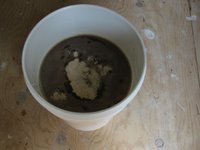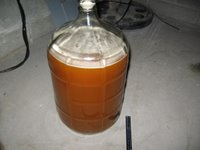
I had my first brewing session back in early June. My first brew was a Brewer's Best Oktoberfest kit. Included in the kit are the speciality grains, malt extract, hops, and yeast. This is a pretty basic kit that proved to be an excellent starting point for craft-brewing.
 A mini-mash consists of "steeping" the speciality grains in 155 degree water. This provides some fermentable sugars for the yeast to feed off of. It also provides color and flavor. The mini-mash usually takes around 35-45 minutes to complete. After the mini-mash is complete the grain bag is removed and discarded. Since a mini-mash does not provide enough fermentable sugar, malt extract is added next.
A mini-mash consists of "steeping" the speciality grains in 155 degree water. This provides some fermentable sugars for the yeast to feed off of. It also provides color and flavor. The mini-mash usually takes around 35-45 minutes to complete. After the mini-mash is complete the grain bag is removed and discarded. Since a mini-mash does not provide enough fermentable sugar, malt extract is added next. After all of the fermentables have been added, the bittering hops are added to the boil. The boil generally lasts 60 minutes, bittering hops are added at the start of the boil. Aroma hops are added at the very end of the boil. These hops don't add much bitterness, but rather a nice finishing aroma and flavor. Now this unfermented beer is called "wort" pronounced "wert". After the boil, it is very important that the wort is cooled to 70 degrees very quickly to prevent any bacteria from getting in the wort.
After all of the fermentables have been added, the bittering hops are added to the boil. The boil generally lasts 60 minutes, bittering hops are added at the start of the boil. Aroma hops are added at the very end of the boil. These hops don't add much bitterness, but rather a nice finishing aroma and flavor. Now this unfermented beer is called "wort" pronounced "wert". After the boil, it is very important that the wort is cooled to 70 degrees very quickly to prevent any bacteria from getting in the wort. After the wort has been chilled, it is time to pitch the yeast. When the yeast has been added to the wort it will begin fermenting, a process which converts sugars into alcohol and carbon dioxide. It is important that the fermenter is air tight so no bacteria can get in the wort. This creates a problem since fermentation creates a lot of carbon dioxide. This problem is solved with an airlock. An airlock is a device that allows air to leave the fermenter, but not to enter.
After the wort has been chilled, it is time to pitch the yeast. When the yeast has been added to the wort it will begin fermenting, a process which converts sugars into alcohol and carbon dioxide. It is important that the fermenter is air tight so no bacteria can get in the wort. This creates a problem since fermentation creates a lot of carbon dioxide. This problem is solved with an airlock. An airlock is a device that allows air to leave the fermenter, but not to enter. After the wort has fermented for 1 week, it is time to "rack" the wort into a secondary fermenter to allow the wort to clear up some more. Most of the fermentation has occurred during the first week, during this time a lot of sediment (called "trub") as settled to the bottom of the fermenter. By racking to a secondary fermenter, the trub is removed from the wort. Racking is accomplished with an auto siphon.
After the wort has fermented for 1 week, it is time to "rack" the wort into a secondary fermenter to allow the wort to clear up some more. Most of the fermentation has occurred during the first week, during this time a lot of sediment (called "trub") as settled to the bottom of the fermenter. By racking to a secondary fermenter, the trub is removed from the wort. Racking is accomplished with an auto siphon. The wort sits in the secondary fermenter for another 2 weeks before it is time to bottle the brew. I didn't get any picture of the bottling procedure, but it is fairly straight forward. A small amount of sugar is added to the beer right before it goes into the bottles. This sugar gives just enough fermentable material to carbonate the brew while it is in the bottles. The bottles must sit at room temperature for 3 weeks. After this conditioning period, the beer is ready to refrigerate and consume!
The wort sits in the secondary fermenter for another 2 weeks before it is time to bottle the brew. I didn't get any picture of the bottling procedure, but it is fairly straight forward. A small amount of sugar is added to the beer right before it goes into the bottles. This sugar gives just enough fermentable material to carbonate the brew while it is in the bottles. The bottles must sit at room temperature for 3 weeks. After this conditioning period, the beer is ready to refrigerate and consume!
